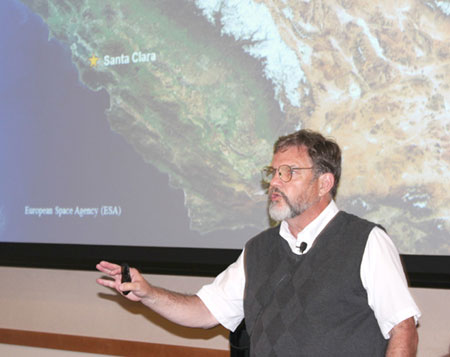
“In my book, I tried to show [characters with] resilience and courage; sadly, there are also stories about hatred and prejudice,” says Gary Noy, author of the non-fiction book, “Sierra Stories: Tales of Dreamers, Schemers, Bigots, and Rogues.” During his talk at the Central Park Library on May 27, Noy shared an enriching history lesson about the people of the Sierra Nevada.
“Tonight’s event enlightened people about Sierra Nevada history, and it reminded us that the people who survived the Sierras went on to other places, including our own Silicon Valley,” says Mary Hanel, the Santa Clara City Library’s recently retired local history librarian.
Noy shared about the Stephens-Townsend Murphy Party, a group that traveled across the Sierras between 1844 to 1845.
“The Stephens-Townsend Murphy Party went over the same routes as the Donner Party, but nobody died,” says Noy, lamenting there is more attention given to the Donner Party. “Sometimes to get [down hills], the travelers [of the Stephens-Townsend Murphy Party] had to dismantle their wagons. Fifty people started out on this journey, and when the journey was over, there were 52 people. Two children were born during this time.”
Elisha Stephens was one of the leaders of the Stephens-Townsend Murphy Party. Stephens settled for awhile in Cupertino. Stevens Creek Boulevard is named after him, in spite of the misspelling of his last name. Another leader of the group was Martin Murphy, Jr., who founded the City of Sunnyvale and a founder of Santa Clara University.
Noy mentioned other names associated with the history of the Sierras.
“In 2013, the National Park Service established the Charles Young Buffalo Soldiers National Monument in Wilberforce, Ohio to honor the contributions of Charles Young and the highly decorated African American army units known as the ‘buffalo soldiers,'” Noy says, adding that Young, once the highest ranked African American army officer, was a superintendent of the Sequoia National Park.
Another big name Noy discussed was John Conness. Born in Ireland, Conness was a miner in the Sierras during the Gold Rush before he became a California Senator.
“The bill Conness introduced in 1864 was Senate Bill 203, the Yosemite Valley Grant Act, which brought [local trees] under California government control,” Noy says. “The bill applied only to the Yosemite and Mariposa grove, but it established the idea that government should protect natural places of beauty, an idea that spread to the rest of the world.”
“Conness lost his reelection in the 1870s,” Noy continues. “There was a big anti-Chinese sentiment then. California politics became anti-Chinese and there was a movement to expand discrimination against the Chinese. Conness was not anti-Chinese. To be elected [into an office] back then, you had to be anti-Chinese.”





